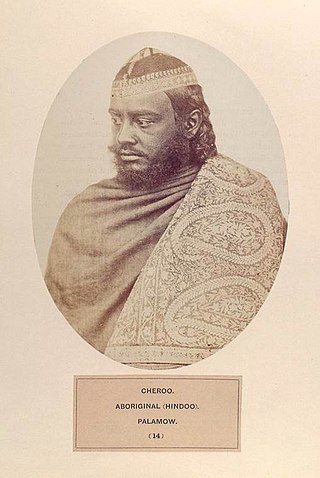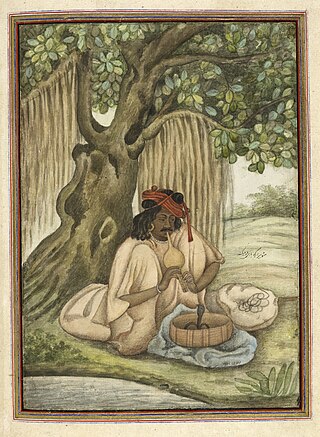Related Research Articles
The Belwar are a Hindu sanadhya Brahmin caste found in North India, and mostly in Uttar Pradesh. Sanadhya Brahmins are called Belwars in mainly Sitapur, Lakhimpur, Hardoi, Barabanki, Gonda and Lucknow. The like to be called Bilwar or Bailwar as it is a matter of pride for them.

Nomads are known as a group of communities who travel from place to place for their livelihood. Some are salt traders, fortune-tellers, conjurers, ayurvedic healers, jugglers, acrobats, actors, storytellers, snake charmers, animal doctors, tattooists, grindstone makers, or basketmakers. Some anthropologists have identified about 8 nomadic groups in India, numbering perhaps 1 million people—around 0.12 percent of the country's billion-plus population. Aparna Rao and Michael Casimir estimated that nomads make up around 7% of the population of India.
The Patwa are a mainly Hindu community native to Hindi Belt.Traditionally, they were Hindu baniya.

Tailoring is the English translation of Darzi. In India, The art and culture of stitched clothes came to India from West Asia. In India, there was a practice of wrapping clothes instead of stitched clothes, an example of which you can see in ancient Indian paintings, in which kings, maharajas and women all used wrapped clothes. In the Indian tradition, it was customary to wrap clothing over the body rather than wear stitched cloth. The word Darzi comes from the west Asia Persian language. In Hindi Darzi is pronounced Darji.

The Chero is a caste found in the states of Bihar, Jharkhand and Uttar Pradesh in India.
The Beldar are a historically nomadic caste, originally from Northern India and now inhabiting many other parts of that country.
The Rauniyar is a Bania caste mostly found in India and Nepal. They use Rauniyar, Gupta, Mahajan, Sah, Shah, Anand, Ranjan, Kashyap, Rauniwal as their surnames.The Rauniyar is a sub-group within the Awadhi Bania community

The Sapera are a Hindu caste found in North India. They are also known as Barwa Sampheriya in West Bengal, Sapela in Punjab and Sparera in Madhya Pradesh.

The Nat are a Hindu caste found in northern India.
The Bandhmati are a Hindu caste found in the state of Uttar Pradesh in India. They are also known as Banbasi.
The Dabgar is a caste found in the states of Gujarat, Rajasthan, and Uttar Pradesh in India. They are also known as Dhalgar and have scheduled caste status in Rajasthan and Uttar Pradesh, while they have Other Backward Class status in Gujarat. In Rajasthan, the community prefer the self-designation as Dhalgar.
The Domar are a Hindu caste found in the state of Karnataka in India.
The Balahar are a Hindu caste found in the state of Uttar Pradesh, India. They are also known as chatriya and have OBC status.
The Gandhila sometimes pronounced as Gandhil and Gandola, are a Hindu caste found in North India. They have scheduled caste status in Punjab and Haryana.
The Kuta are a Hindu caste found in the state of Uttar Pradesh in India. They are also known as Dhankuta.
The Kalabaz are a Hindu caste found in the state of Uttar Pradesh in India. They have Scheduled Caste status.
The Khairaha are a Hindu caste found in the state of Uttar Pradesh in India. They have Scheduled Caste status.
The Kuthaliya Bora are a Hindu caste found in the state of Uttarakhand in India. They are also known as Bora Karki.
The Jhamar are a Hindu caste found in the state of Uttar Pradesh in India. They are also known as Jhaunwar.
The Hurkiya are a caste found in the states of Uttar Pradesh and Uttarakhand in India. They have been granted Scheduled Caste status in both these states. In fact, there are two distinct communities that go by the name Hurkiya, those of Uttarakhand, who are Hindu by religion, and those found in western Uttar Pradesh, who are Muslim. Both Hurkiya are of common origin, being a sub-group within the Dom ethnic group, and are one of the many gypsy like grouping found in North India.
References
- ↑ People of India Uttar Pradesh Volume XLII Part Three edited by A Hasan & J C Das page 1142 to 1146 Manohar Publications
- ↑ People of India Uttar Pradesh Volume XLII Part Three edited by A Hasan & J C Das, page 1142–1146 Manohar Publications
- ↑ People of India Bihar Volume XVI Part Two edited by S Gopal & Hetukar Jha pages 770 to 771 Seagull Books
- ↑ People of India Uttar Pradesh Volume XLII Part Three edited by A Hasan & J C Das page 1142 to 1146 Manohar Publications
- ↑ People of India Bihar Volume XVI Part Two edited by S Gopal & Hetukar Jha pages 770 to 771 Seagull Books